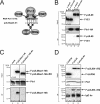Phosphosite Analysis of the Cytomegaloviral mRNA Export Factor pUL69 Reveals Serines with Critical Importance for Recruitment of Cellular Proteins Pin1 and UAP56/URH49
- PMID: 31969433
- PMCID: PMC7108844
- DOI: 10.1128/JVI.02151-19
Phosphosite Analysis of the Cytomegaloviral mRNA Export Factor pUL69 Reveals Serines with Critical Importance for Recruitment of Cellular Proteins Pin1 and UAP56/URH49
Abstract
Human cytomegalovirus (HCMV) encodes the viral mRNA export factor pUL69, which facilitates the cytoplasmic accumulation of mRNA via interaction with the cellular RNA helicase UAP56 or URH49. We reported previously that pUL69 is phosphorylated by cellular CDKs and the viral CDK-like kinase pUL97. Here, we set out to identify phosphorylation sites within pUL69 and to characterize their importance. Mass spectrometry-based phosphosite mapping of pUL69 identified 10 serine/threonine residues as phosphoacceptors. Surprisingly, only a few of these sites localized to the N terminus of pUL69, which could be due to the presence of additional posttranslational modifications, like arginine methylation. As an alternative approach, pUL69 mutants with substitutions of putative phosphosites were analyzed by Phos-tag SDS-PAGE. This demonstrated that serines S46 and S49 serve as targets for phosphorylation by pUL97. Furthermore, we provide evidence that phosphorylation of these serines mediates cis/trans isomerization by the prolyl isomerase Pin1, thus forming a functional Pin1 binding motif. Surprisingly, while abrogation of the Pin1 motif did not affect the replication of recombinant cytomegaloviruses, mutation of serines next to the interaction site for UAP56/URH49 strongly decreased viral replication. This was correlated with a loss of UAP56/URH49 recruitment. Intriguingly, the critical serines S13 and S15 were located within a sequence resembling the UAP56 binding motif (UBM) of cellular mRNA adaptor proteins like REF and UIF. We propose that betaherpesviral mRNA export factors have evolved an extended UAP56/URH49 recognition sequence harboring phosphorylation sites to increase their binding affinities. This may serve as a strategy to successfully compete with cellular mRNA adaptor proteins for binding to UAP56/URH49.IMPORTANCE The multifunctional regulatory protein pUL69 of human cytomegalovirus acts as a viral RNA export factor with a critical role in efficient replication. Here, we identify serine/threonine phosphorylation sites for cellular and viral kinases within pUL69. We demonstrate that the pUL97/CDK phosphosites within alpha-helix 2 of pUL69 are crucial for its cis/trans isomerization by the cellular protein Pin1. Thus, we identified pUL69 as the first HCMV-encoded protein that is phosphorylated by cellular and viral serine/threonine kinases in order to serve as a substrate for Pin1. Furthermore, our study revealed that betaherpesviral mRNA export proteins contain extended binding motifs for the cellular mRNA adaptor proteins UAP56/URH49 harboring phosphorylated serines that are critical for efficient viral replication. Knowledge of the phosphorylation sites of pUL69 and the processes regulated by these posttranslational modifications is important in order to develop antiviral strategies based on a specific interference with pUL69 phosphorylation.
Keywords: ICP27; herpesviruses; human cytomegalovirus; mRNA export; pUL69; protein phosphorylation.
Copyright © 2020 American Society for Microbiology.
Figures









References
-
- Sandri-Goldin RM. 2001. Nuclear export of herpes virus RNA. Curr Top Microbiol Immunol 259:2–23. - PubMed
Publication types
MeSH terms
Substances
LinkOut - more resources
Full Text Sources
Research Materials
Miscellaneous

